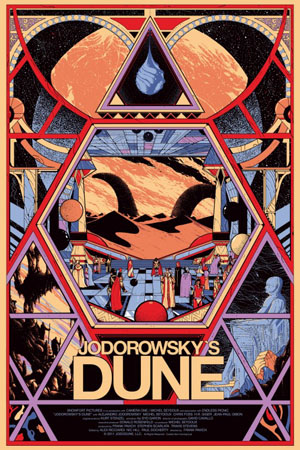 JODOROWSKY’S DUNE
JODOROWSKY’S DUNE(PG-13)
*** (out of 5)
March 21, 2014
STARRING
Alejandro Jodorowsky as HIMSELF
Michel Seydoux as HIMSELF
H.R. Giger as HIMSELF
Chris Foss as HIMSELF
Brontis Jodorowsky as HIMSELF
Richard Stanley as HIMSELF
Studio: Sony Pictures Classics
Directed by: Frank Pavich
BY KEVIN CARR
Listen to Kevin’s radio review…
Let me start this review for “Jodorowsky’s Dune” with the up-front admission that I am a die-hard fan of David Lynch’s version of the film. This is not meant to be a long-form apology for the movie because even if Lynch has mixed feelings about his own work, I will always contend it is a work of genius. I may be the only one, but that’s my opinion.
Instead, I’m coming at “Jodorowsky’s Dune” as someone who read the book and also enjoyed the movie version we got. (To be honest, I never watched the TV versions of the series that were aired on SciFi back in the 90s, but there you go.) I never felt there was a great level of unfulfillment to the adaptation. I never felt regret that we didn’t get the perfect adaptation of Frank Herbert’s classic novel.
This, I feel, gives me a unique perspective to this subject matter because it appears that many people – including the folks interviewed in this movie – feel this was the greatest lost opportunity in cinema history. Instead, I can look back on this story as a sign of the time in which it took place and an effort that in all reality was never going to come to fruition.
“Jodorowsky’s Dune” examines how maverick filmmaker Alejandro Jodorowsky was developing an adaptation of Frank Herbert’s book in the early 1970s. Throughout the film, we see concept art, development pieces and production design that show what could have been. Jodorowsky assembled one of the most impressive teams in the history of cinema, and through interviews and archival photographs, we get a glimpse at a group that later influenced many elements in world cinema.
The story behind “Jodorowsky’s Dune” is something that could only happen in the 1970s. This was a time where Hollywood – and the world at large – were taking some significant risks. The events that took place during the development of the “Dune” project were things that could only happen in the world of LSD and casual sex, in the era when X-rated porno chic took place and the MPAA ratings system hadn’t yet been corrupted to Hays Code levels.
Of course, knowing that Jodorowsky never made his version of “Dune” leads the ending of the film a bit, but that’s an obvious thing because even a rudimentary knowledge of science fiction film history tells us this never existed. In a way, this is like watching “Sunset Boulevard” and waiting to find out exactly how Joe Gillis dies.
The tragic flaw in Jodorowsky’s approach was something that has plagued filmmakers for years. More recently, it killed Guillermo del Toro’s vision of an R-rated $150 million adaptation of “In the Mountains of Madness” (a movie I’d love to see but doubt will ever get made to the director’s specifications). “Jodorowsky’s Dune” shows the audience the dreaded budgetary gap between a director’s vision and a studio’s pocketbook. The artists don’t accept the need for commercial viability, and the studio doesn’t accept the need for artistic integrity.
Knowing the full story of “Jodorowsky’s Dune” makes me want to ponder through the behind-the-scenes mock-up that the director has, and I’m not alone in this matter. I still would love to have seen what would have come from this endeavor, and it is this curiosity that is the real legacy of the documentary.
Podcast: Play in new window | Download
